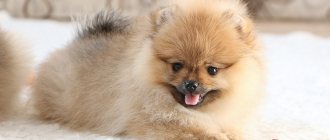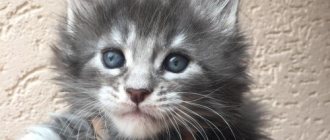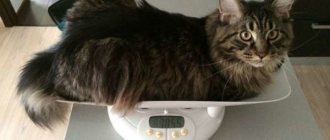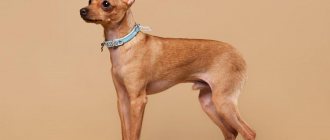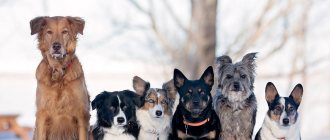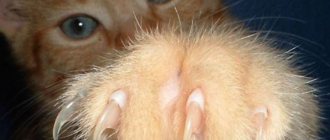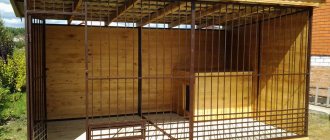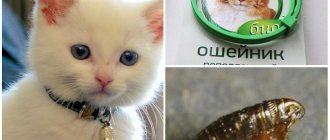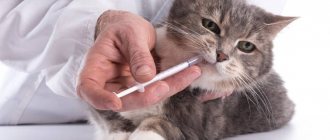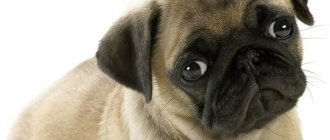Brief characteristics of the breed
Males:
Bitches:
What is the price:
Life expectancy: 10-15 years. |
How is a miniature poodle different from a miniature poodle? | The small (or medium) is larger than the dwarf, the height at the withers is up to 35-45 cm. It is more hardy, but less mobile than the dwarf. |
Is it true that poodles do not shed and do not have the characteristic dog smell? | Indeed, they do not leave fur behind and are perfect for keeping in an apartment. The hair, of course, falls out, but in small quantities, and remains on the poodle. Regular care, including washing and cutting, can remove it. The poodle does not smell like a dog due to inactive sebaceous glands. Its fur will have an odor depending on the conditions of its detention. Please note that the sebaceous glands do not work well only in purebred individuals. |
Can dog fur cause allergies? | This is the most suitable dog for those who suffer from allergies. To prevent allergens from accumulating, you will need to wash your pet once every day. in 10-14 days. It is recommended to use special hypoallergenic cosmetics. |
Is it difficult to train? | No. This is the easiest breed to train. These are the dogs that most often take part in circus performances. They love to learn, they like to bring joy to their owner. |
Who are they suitable for? | Most suitable for people leading a measured lifestyle, pensioners, children over 7 years old, due to the characteristics of the animal’s intelligence and temperament. |
Who is better to choose: a girl or a boy? | Males are more temperamental. Bitches have a calm character and are more attached to their owner. There are some differences in care: you will have to walk a male dog longer, as he tends to mark his territory. The bitch goes into heat twice a year, and then you will only have to walk her on a leash, away from other dogs. If you plan to take part in exhibitions, it is better to take a male, since females lose their shape after giving birth and lactation for several months. |
Who is this dog breed not suitable for? | Homebodies, quiet people who love silence, as well as very young children. Because of the child’s mischief, the dog may experience stress or will not tolerate it calmly. |
Advantages of the breed
- They have an original appearance and lively temperament.
- They are not aggressive towards cats or other dogs, they are playful, and are suitable for any family.
- Its small size allows you to keep a dog even in a small apartment.
- They don't shed, don't smell like dog, and don't cause allergies.
- These are loyal, very easy-going pets that get along well with children.
- Very smart. In terms of intelligence, they are in 2nd place (collies are in 1st place).
- They are extremely trainable.
- The characteristics of the Miniature Poodle breed include good guarding qualities. “Dwarves” are wary of strangers and bark in defense of their owner and their own territory.
Disadvantages, difficulties in care
- Nervous, excitable. They tend to bark a lot and for a long time, especially at a young age. Any sounds can become an irritant.
- Some representatives of this breed are timid and fearful.
- They may react sharply to loud voices and emotional tension in the family. Animals tolerate stress very poorly, which can cause gastrointestinal disorders and nervousness.
- The pet cannot be left alone for a long time; it cannot stand loneliness and suffers from lack of attention.
- The coat requires special care; it needs to be combed and trimmed regularly. In addition, the animal must be washed frequently.
- A disadvantage for calm people who love silence may be the mobility of the pet. “Dwarves” are almost always constantly on the move, running, jumping, and playing a lot.
- Since these dogs need to move a lot, walking should be intense (at least 1 hour a day). If physical activity is not enough, the pet will bark a lot, chew things, and may become aggressive.
Toy poodle
When compared with other varieties of poodle, the “toy” appeared relatively recently. These little ones grow from 23 to 28 cm at the withers and weigh no more than three kg. The Toy Poodle is considered one of the most “comfortable” apartment dogs due to its small size.
There are six officially recognized standard solid colors for Toy Poodles:
- White.
- Black.
- Grey.
- Ginger.
- Peach (apricot).
- Chocolate (brown).
Toy is translated from English as a toy, which is actually not far from the truth: the dog looks like a toy.
The Toy Poodle has a dense, wavy coat with no undercoat. Toy, like his larger brothers, is a very smart dog and is easy to train.
The difference is that they are not as active as, for example, dwarf ones. They are very devoted to their owner, require constant attention and care, and cannot stand loneliness.
When in contact with other animals, the toy poodle is weakly active and prefers to stay on the sidelines. When communicating with them, he will behave warily and cautiously.
Nutrition
The nutrition of puppies and adults must be approached carefully, as is the case with dwarf poodles. Toy poodles can be fed both dry food and natural food. But it is still preferable to give wet food or natural food to avoid abrasion of tooth enamel when chewing dry food.
Small puppies and adult toy poodles need to be fed in the same way as dwarf ones, the only difference is in the dosage of portions, which in any case is individual. It is important to remember that a properly selected and healthy diet directly affects the growth rate and overall health of your four-legged friend. It is necessary to regularly visit the veterinarian and monitor the health of your pet. Following all the recommendations will benefit the dog, help it develop properly and feel healthy.
Care
It is necessary to care for a toy poodle in the same way as for a dwarf one. There are no fundamental differences in the care and nutrition of toy and miniature poodles. You need to monitor the condition of the dog’s fur, bathe and comb it, and look after its teeth, gums and claws. You definitely need to vaccinate your dog.
The only thing to watch out for is that poodles are prone to joint dislocations, so you need to be careful when handling this dog while it is at a young age. You also need to pay attention to your pet’s ears and eyes. If you carefully monitor the health and nutrition of your toy poodle, he can live up to 18 years, which is an indicator of longevity in dogs.
Useful materials:
- Cutaneous horn General description of the disease Cutaneous horn on the forehead or face (ICD 10 code - L57.0) -...
- Itching and odorless discharge Main causesBefore considering the factors that provoke the appearance of discharge that has a sour odor, it is necessary to immediately note...
- Normal temperature in animals Normal temperature in different types of animals Veterinary services Day hospital for animals Veterinary certificates Vaccination…
- Discharge in women What kind of discharge between menstruation is considered normal? Female discharge normally consists of mucus from the cervical canal, dead...
Photo of a miniature poodle
Character, behavioral characteristics
Dwarf (miniature) poodles are quite hardy, cheerful, and playful. They are very active, sociable, and love attention. Loneliness is destructive for them. These dogs are very sensitive and require careful handling and delicacy.
Learning abilities
Sociable, easy to learn. They are very demanding of attention and accept any manifestations of it, including training, with joy. Dogs of this breed are very smart, they understand everything perfectly and can quickly master many commands. It should be borne in mind that harsh training is unacceptable; the poodle requires a polite attitude.
It is very important to start training in a timely manner, since the pet quickly develops such a character trait as perseverance. He will often act in his own way, this behavior will be very difficult to change.
Attitude towards the owner, strangers, other animals
These dogs have very developed empathy - the ability to empathize, they subtly sense the mood of the owner. This is a true companion, quickly acquiring those behavioral characteristics that are more interesting to the owner.
The Miniature Poodle will be a good friend for children over 7 years old, as they love to play. However, if the child is overly aggressive, there is a risk that the animal will develop mental health problems. This breed is not suitable for small children.
"Dwarf" can sometimes be jealous of the owner of other pets. He is more comfortable in the company of people than in the company of animals. Sometimes he shows fear and caution towards strangers, but not aggression, but he can bark at strangers. The dog will always react to any noise outside the door by barking.
Character and intelligence
All poodles are highly intelligent, easy to train and can master complex tricks with interest. When living in a family, the dog quickly remembers the basic phrases of those around him and begins to understand not only commands, but also speech addressed to him.
We recommend reading: Nickname for a girl's dog Jagdterrier
Toy poodles have a cheerful and active character. They become very attached to their owners and require a lot of attention. These dogs do not tolerate loneliness well, which is why they cannot remain alone in an apartment for a long time without damaging their psyche. If your toy poodle is forced to be alone during the day, you should have a second pet ( dog or cat ) with whom he can communicate. Otherwise, you cannot have this breed.
Attitude towards children and others
Poodles willingly take part in children's games, but only if this does not cause them any unpleasant sensations. When children try to force a dog to communicate, it may display its hunting nature and use its teeth. Because of this, adults should explain to the child that the poodle is not a toy, but a full member of the family that should be taken into account.
The toy poodle behaves friendly with other pets and quickly finds a common language with them. He will willingly communicate not only with dogs close in size to him, but also with large ones, as well as cats.
The Toy Poodle is friendly towards strangers. He will willingly play with guests if they want it, but he will not impose himself. The pet is indifferent to passers-by on the streets: he does not try to get to know them and does not show aggression.
Care
Care and maintenance of a dwarf poodle has its own peculiarities.
- Bathing: at least 1 p.m. per month or as pollution occurs. If the procedure is regular, it will take less time, since the hair will not roll off. Before bathing, place cotton swabs in the dog’s ear canals, which must first be moistened with petroleum jelly.
- Combing with a stiff brush: daily. It replaces massage and improves blood circulation.
- Haircut: at the groomer or at home (using a clipper) - at least 1 p.m. at 2 months
- Ear care: regular checkups. If you notice discharge or an unpleasant odor, you should take the dog to the veterinarian.
- Eyes: examination, rinsing with warm water, weakly brewed tea. The following symptoms require contacting a veterinarian: tearing, redness, signs of souring.
- Teeth: keeping clean, dental cleaning.
- Paws: wash after every walk. Inspect for cracks and damage.
- Nail care: trim with a nail clipper 1-2 times a month. followed by filing.
- Vaccinations: the main one is against plague and parvovirus at the age of 6-8 weeks. Revaccination – after 2-3 weeks. In 10 days before vaccination – deworming, flea and tick treatment. The injection is given only to healthy puppies. If the dog has been ill with something, it can be vaccinated no earlier than after 12-14 days. after recovery. After vaccination, the puppy must be protected from hypothermia; walking is allowed only after 10-12 days.
Signs of Healthy Development
Poodle owners claim that dogs of this breed are distinguished by excellent health. The health of a poodle is judged by the following signs:
- A healthy dog is active, mobile, with a good appetite. Has an adequate reaction to the actions of the owner, is not aggressive.
- The coat should be thick and without bald patches. A poodle sheds no more than twice a year.
- The nose, like that of any other dog, should be wet and cold.
- Eyes without pus discharge.
- Breathing is smooth and infrequent. Wheezing is an indicator of illness.
- The oral mucosa and tongue should be pink, without drooling.
- A litter box/outdoor trained dog should not “do business” in an unspecified place. This may indicate incontinence or diarrhea.
A haircut
Grooming your toy poodle can be done at home. Place the dog on the table. For a dog to stand still, it must be on a leash. If this is your first haircut, show the clipper to the animal and let him sniff it. Then simply turn on the device without starting the procedure so that the dog can get used to the unfamiliar object and stop being afraid.
Head and neck haircut
- With one hand, grab the dog by the muzzle, and with the other hand, fold one ear back. While holding the dog, clip the hair with a clipper, drawing a line from the curled ear to the nose, then from the ear to the corner of the eye.
- Trim the fur on the cheek, then above the eye, under the eye.
- Lift the dog's head up and trim the hair on the neck.
- Cut the dog's hair on the other side in the same way.
Paw trimming
- Grasp the dog's paw with your left hand, with your thumb on top. Trim the fur.
- Then you need to remove it from your fingers. Make the dog bend its paw at the ankle. Trim off the fur between the fingertips.
Tail cut
- When cutting the tail, the clipper should move from its base to the end. Leave a pompom at the end of the tail.
- Trim the fur between the hind legs, first lifting the animal's tail.
Belly haircut
- Place the dog on its hind legs, holding it by its front legs. Trim it by pointing the clipper from the navel down the inner thighs to where the fur begins to thicken.
- Trim the belly, lifting the dog's paws one at a time.
Popular haircuts
To achieve a certain haircut, do not remove hair on certain parts of the body.
- "A lion". Trim the back of the body to the level of the ribs. Trim the fur on the face, tail, and paws. Leave the pom-poms on the ankles and tail.
- "Modern". Trim the hair on the face, back (from the withers), and croup. No need for paws. Hair of 1 cm in length is left on the belly and sides.
- "Bikini". The dog should have short hair all over its body. Pompoms are left on the ankles and the tip of the tail.
Poodle sizes
Poodle sizes
Nika » 03 Jan 2006, Tue 14:45
Arina » 03 Jan 2006, Tue 16:29
samalin » 04 Jan 2006, Wed 11:10
Poodles have 4 height varieties. Toy poodle - up to 28 cm. Miniature poodle - from 28-35 cm. Small poodle - from 38-45 cm. Large poodle - from 45 -62 cm. I will add that the upper barrier of the large poodle has recently been removed. Now they can be 70. Poodles can have different colors. There are white, black, brown. These are classic colors. And modern color is silver, apricot. There is also red, but it is considered officially unrecognized. Although these dogs are exhibited under the guise of apricots. Now a petition has been submitted to the French Poodle Club to recognize this color as a separate one. All poodleists are eagerly awaiting a decision. About poodle rings. According to the FCI system. Toys all go in one ring, without dividing by color. All colors are together. Dwarfs, small and large, are divided by color. White, black, brown go separately. They choose one best representative of the breed from these colors. He goes to BEST.
And separately apricot and silver. And of these colors, only one representative of the breed goes to Best.
Arina » Thu Jan 26, 2006 9:19 pm
It turns out that the following are going to BEST: 1 toy, 2 dwarfs, 2 small, 2 large
samalin » 26 Jan 2006, Thu 21:32
Arina » Fri Jan 27, 2006 10:04 pm
Toy poodle - help.
Sothys » 26 Feb 2006, Sun 21:33
Diseases
Most often identified:
- tearfulness,
- ear infections,
- otitis,
- deafness,
- epilepsy,
- retinal atrophy,
- heart disorders,
- autoimmune anemia,
- diabetes,
- dental problems.
Miniature poodles have a genetic predisposition to narrowed nasal passages. As a result, breathing becomes difficult, wheezing and snoring appear. The problem is eliminated surgically. A defect such as a “cleft palate” (cleft of the hard palate) is often identified.
Due to lop ears, animals are prone to ear diseases (inflammation, ear mite damage). Be sure to ensure that when bathing your pet, no water gets into its ear canals. If this happens, remove it carefully.
To prevent tartar, you need to regularly brush your animal’s teeth using special food and treats. To prevent your pet from developing any pathologies of the cardiovascular system, try not to expose him to stress. Any stress, including psycho-emotional, should be moderate.
A veterinary first aid kit is a must. It should contain:
- thermometer+vaseline,
- cotton wool,
- bandage,
- syringe,
- tweezers,
- eye pipettes,
- rubber tourniquet, hemostatic.
You will also need disinfectants:
- iodine,
- hydrogen peroxide,
- chlorhexidine,
- brilliant green,
- streptocid.
Additionally purchased:
- antispasmodics, painkillers - “No-shpa”;
- antihelminthics - “Azinox”, “Prazid”;
- anti-tick products - “Bars”, “Dana”, etc.;
- cardiac - valerian drops, caffeine;
- remedies for poisoning - activated carbon (Polyphepan, Enterosgel), castor oil, Glauber's salt.
Origin story
This breed appeared not so long ago, during the period of fashion for hunting dogs. The mini poodle cannot be called an aggressive protector or hunter, since its main task was to serve as a kind of page. This dog could catch killed game from the water and present it to its owner. There are many varieties of this breed. All of them have received international recognition, including the toy poodle.
Puppies: selection and care
Before choosing a dwarf (miniature) poodle puppy, it is recommended to study the description of the breed. To buy a purebred dog, of course, it is better to contact breeders. Color does not affect the quality of the animal, but the difficulty of care depends on it.
The white dog is very photogenic, but it is more difficult to care for. Whitening shampoos will be needed to remove yellow spots, especially where the coat gets particularly dirty (paws, ears). Less hassle with caring for brown and black dogs.
The white coat may have a slightly creamy tint, which fades with age. However, if the color is apricot or darker, most likely the dog will remain that way. Silver puppies may be black at birth; the silver color appears starting at 6-8 weeks of age.
Do not forget that this is a companion dog, so you need to choose it taking into account your lifestyle and temperament. When examining all the puppies, it is not necessary to give preference to the most active one. An active and lively dog is not suitable for those who like leisurely walks. In this case, it is better to choose a calmer one.
When inspecting, pay attention to the following points:
- the eyes should not become sour or watery;
- there should be no rash on the skin;
- if the tail is dirty, the fur under it is stuck together, then the dog has digestive problems;
- The inside of the ears should be odorless and without any signs of ear mites.
Care
In the first 4 months, the puppy requires more careful care. The optimal air temperature in the room should not be less than 16-18 ºС. The pet needs to be allocated a place - a clean, bright space in the room (not in the kitchen or bathroom), drafts are unacceptable. You can’t place bedding near a battery either. List of required items:
- slicker,
- a comb with long, but not very frequent teeth,
- hair clipper,
- shampoo,
- hair dryer,
- nail clipper, file.
Walking: required for harmonious growth and development. Movement helps the body become stronger. A puppy under 3 months old has not yet strengthened his back, and it is harmful for him to move up stairs. You have to carry him outside in your arms. If you are planning a long walk, you should go out no earlier than an hour after feeding.
Important: these dogs have almost no undercoat and do not tolerate cold well. You need to walk with your puppy at a fast pace; active games will help you warm up. It is recommended to purchase clothes for walking. In order for a dog to adapt to the cold, you need to walk it for 3-4 days. per day for 20-30 minutes, gradually increasing the time to 30-40 minutes. If your pet shows signs of freezing (trembling, clenching its paws), you need to return home.
- Bathing: 1 time per week.
- Combing: daily.
- Haircut: at least 1 p.m. at 2 months
Basic care rules
In order for your puppy to grow up healthy and happy, you need to care for him by following some rules:
- In the first days, be extremely attentive to the puppy and be affectionate with him. It was hard for him to move to a new house; he misses his mother and brothers. You must show him that you do not pose any danger, but on the contrary.
- If there are children in your house, then it is worth explaining to them that the animal is not a toy. You should not disturb him while he sleeps or pull his paws or ears. Show how to properly handle your new pet.
- The pet must have its own place to sleep and rest. Don't disturb him if he settles on it to catch his breath.
- The dog should have its own toys. As he grows up, he will have a need to chew on something and play with something. It would be better if it were his things than yours.
- Make sure that there are no things valuable to you or anything small that are dangerous for him on the floor or in the dog’s access area.
- Start teaching him his name and hygiene procedures: trimming his nails, cleaning his ears, rubbing his eyes, and checking his teeth. He must get used to the fact that such things will be repeated regularly.
- When walking outside, do not let your puppy pick up any objects from the ground, especially not eat or chew them. Do not let your dog off the leash unless you are sure that it is accustomed to you and will not rush after the first car or cyclist.
- The puppy should always have clean water freely available.
- Do not forget how many times a day you need to feed the puppy, and also that gradually the number of meals should be increased to twice a day.
We recommend reading: How to inject a dog with oxytocin during childbirth
Feeding a Miniature Poodle
Age 8-10 weeks.
Feeding frequency: 4-5 r. a day, at the same time.
Ready-made food is given in accordance with the instructions indicated on the packaging. No other food can be fed.
Natural food. During the day you need to alternate between meat and dairy feeding.
Meat: Boil rice, buckwheat. Finely chop the raw meat and scald it with boiling water. You can boil it first. Mix the porridge with meat in a ratio of 1 to 2. Add a small amount of grated apple (or carrots) and sunflower oil. Instead, you can add a little vitamin-mineral mixture (according to the information on the package).
Dairy: Fermented milk products (cottage cheese, kefir), raw or boiled egg yolk. It is allowed to add a small amount of porridge (buckwheat, rice), chopped fruit (banana, apple). The puppy is not allowed milk.
Age 10 weeks. — 4 months
- Feeding frequency: by the age of 4 months. gradually reduce to 3. If your dog asks to eat between feedings, it means he is not getting enough. In this case, feed her 4 times. in a day.
- The composition of the diet is similar.
Age from 4 months. up to six months
- Feeding frequency: 3-4 r. in a day.
- Ready-made feed. Replaced from Puppy to Junior. This should be done gradually, following the manufacturer's instructions.
- Natural food. Some of the meat can be replaced with offal or boiled fish (sea fish), after removing the bones.
Age 6 months - 1 year.
- Feeding frequency: 3-4 r. in a day.
- Ready-made feed. After changing the incisors, switch your pet to adult food.
- Natural food. The composition of the diet is the same. The amount of feed is determined individually, experimentally. The volume of food is calculated in such a way that the dog eats everything without leaving a trace, but does not overeat.
Age from 1 year
- Feeding frequency: 3 times. in a day.
- Ready-made food: in accordance with the instructions on the packaging.
- Natural food. The diet of a miniature poodle under the age of 1.5 years should contain mainly meat - 2/3 of the part. For a pet over 1.5 years old, the amount of meat is reduced to 1/3, porridge, and other food is increased to 2/3.
Misconception: Why is my dog not growing?
Dog owners are often mistaken about their pets, and this also applies to their size. In this regard, they begin to look on forums for an answer to the question of why the dog is not growing, forgetting that this is impossible.
Owners often fall into misconceptions about the size of puppies:
- The puppy has stopped growing and will be a dwarf . This is not true: puppies grow actively until they are 6 months old, then growth and weight gain occur less actively and unevenly. The indicator can also be affected by illness, lack of physical activity, and lack of vitamins.
- A small animal cannot protect me . This is not true: height and defensive ability are in no way dependent on each other. A dog trainer is able to train any animal to resist attacks on you.
Owners should understand that a puppy cannot stop growing, they just don’t notice it. If you show a puppy to someone who hasn't seen it for a while, they will definitely notice a change in appearance.
Even if you regularly take measurements and write down readings, it may turn out that the dog has relaxed his muscles a little, twisted, the ruler has moved out of place, etc.
In order for your dog to be physically developed, he needs to be fed properly and actively walked, and in order to protect you, he needs to be trained and be a friend to the dog.
Thus, the growth process of a dog goes through several stages. It is important that puppies can grow at the withers up to 1.5 years of age, and the larger the breed, the longer growth will continue. By the age of 3 years, the puppy will acquire the appearance of an adult animal.
Don’t worry too much about your pet’s growth—everything has its time, and a dog of any size will be able to protect you.
Raising a puppy
Remove items that your puppy might chew on. Instead, there should be toys on the floor: balls, branches, etc. The dog must know and flawlessly follow the commands:
- “stop!”, “come to me!”, neglect can lead to disastrous consequences (for example, a dog can get hit by a car by running out onto the roadway);
- “Ugh!”, the command will help teach your pet not to pick up food on the street.
If you plan to participate in exhibitions in the future, you need to teach your pet:
- be calm when examining your teeth;
- show yourself in motion (prancing light gait while maintaining beautiful posture, perky mood, confidence);
- stand correctly (head raised high, hind legs slightly back, tail positioned upwards).
Standards
| Usage | Companion dog |
| Appearance | Proportionally built, with curly or corded coat. |
| Temperament, behavior | Active, combining dignity, elegance, attentive, obedient. Loyal, capable of training. |
| Head |
|
| Frame |
|
| Legs |
|
| Gait | Springy and light |
| Wool | Curly: dense, thick, curled, elastic. Corded: thinner, forms cords with a length of 20 cm. |
| Color | Solid color, 5 colors: black, brown, white, apricot, silver (without transitions, spots, or other marks). |
| A haircut |
If a poodle has a haircut different from those specified in the standard, it will not be allowed to participate in the exhibition or undergo examination. |
Deviations from standards
It happens that a miniature poodle puppy grows into a rather large animal, and sometimes it is inferior in height and weight to a toy poodle. Is this so bad, and is it worth immediately running with your fists to the people who sold the “low-quality” pet?
In fact, this happens. Even dogs with the purest pedigree can give birth to a puppy that does not fit the breed parameters, although this does not happen very often. Don't be alarmed if your toy poodle puppy grows a little larger than his brothers and sisters.
If the height and weight deviate slightly from the norm for miniature poodles, but do not in any way affect the health and well-being of the dog, then there is nothing to worry about, unless you want to participate in shows and exhibitions.
The main thing is to love your four-legged friend, and he will reciprocate your feelings.
